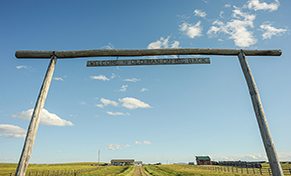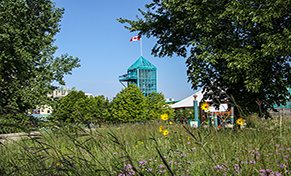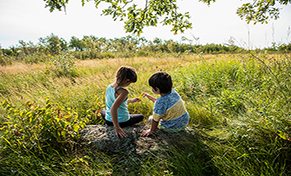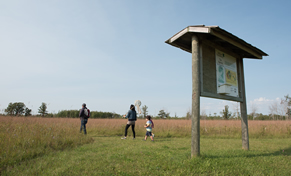PRAIRIES & PARKLANDS
Federal ecozones: Prairies
Area: 463,629 km2
Natural cover: 148,635 km2
Per cent natural: 32%
Protected area: 29,136 km2
Per cent protected: 6%
Number of NCC projects (all): 587
Number of species of birds: 309
Number of species of trees: 60
Number of species of mammals: 89
Number of species of amphibians: 17
Estimated human population: 5,890,838

Description
The Prairie region in Canada extends from the Rocky Mountains in southern Alberta through Saskatchewan and into the Red River valley in Manitoba. These grasslands are the northern extent of the Great Plains that continue south into Mexico.
Vegetation on the prairies changes in response to their location. Most of the southern and central prairies are dominated by spear grass, blue grama grass and wheat grass. The parklands are a transition between the prairies and boreal forests and are characterized by trembling aspen with fescue grasslands. Fescue grasslands also occur in the western part of the prairies, while tall grass prairie can be found in eastern Manitoba.
Prairies & Parklands Landscape

Conservation Values
Temperate grasslands, including Canada’s prairies and parklands, have been identified as the most endangered ecosystem on the planet. Some of the largest and best examples of native prairie remaining in North America are in Canada.
The prairies contain many species that are not found elsewhere in Canada, including the Poweshiek skipperling, hairy prairie-clover and mountain plover.
In addition to grasslands, the prairies contain a wide diversity of wetland habitats. Characteristic species of the prairies and parklands include bison, pronghorn antelope, burrowing owl, swift fox and black-tailed prairie dog.
Challenges/Threats
The prairie region has been heavily impacted by habitat loss. More than 70 per cent of the prairie grasslands have been converted to cropland. In Manitoba, only one per cent of the original tall grass prairie remains.
Losses of native prairie grasslands are continuing due to rising commodity prices and new varieties of cultivated crops. One study found this continued decline to be significant. Between 2009 and 2015, the annual rate of grassland conversion in North America’s Great Plains was two per cent, with some of the highest conversion rates in Canada. Increasing energy development is also a threat.
Climate change may reduce the amount of land that can be cultivated in the southern prairies due to drought, but increasing growing days may expand agricultural land further north. Invasive species are impacting many of the remaining grassland remnants.
The loss of prairie grasslands has resulted in the rapid decline of many species, including various songbirds. Birds such as Sprague’s pipit, mountain plover and greater sage-grouse have lost more than 80 per cent of their populations since the mid-1960s.
What NCC is doing
NCC has identified priority conservation sites in a number of natural areas, including:
- Cooking Lake Moraine
- Cypress Uplands
- East Parklands
- Frenchman River Watershed
- Milk River Basin
- Milk River Ridge
- Missouri Coteau
- Oak Lake Sandhills and Wetlands
- Old Man on His Back
- Pakowki Lake
- Tall Grass Prairie
- Upper Qu’Appelle
NCC’s work on the prairies includes building on and linking existing protected areas, working with ranchers to maintain native grasslands and supporting recovery efforts for species at risk. Species at risk protected by NCC include plains bison, swift fox and McCown’s longspur.

Did you know?
- Temperate grasslands, including Canada’s prairies, are the world’s most endangered ecosystem.
- Over 70 per cent of Canada’s prairies have been converted to other land uses.
- Grassland birds are declining faster than almost any other group of birds in North America.
- Canada’s prairies provide habitat for 50 per cent of North America’s waterfowl.
- Depending on precipitation, there are between 1.6 and 7.1 million wetlands in this ecozone.
- Some of the best examples of intact grasslands in North America are in Canada.
Photo Credits (Top to bottom): iStock; iStock; Robert Berdan; Thomas Fricke; CNC; Don Dabbs.







